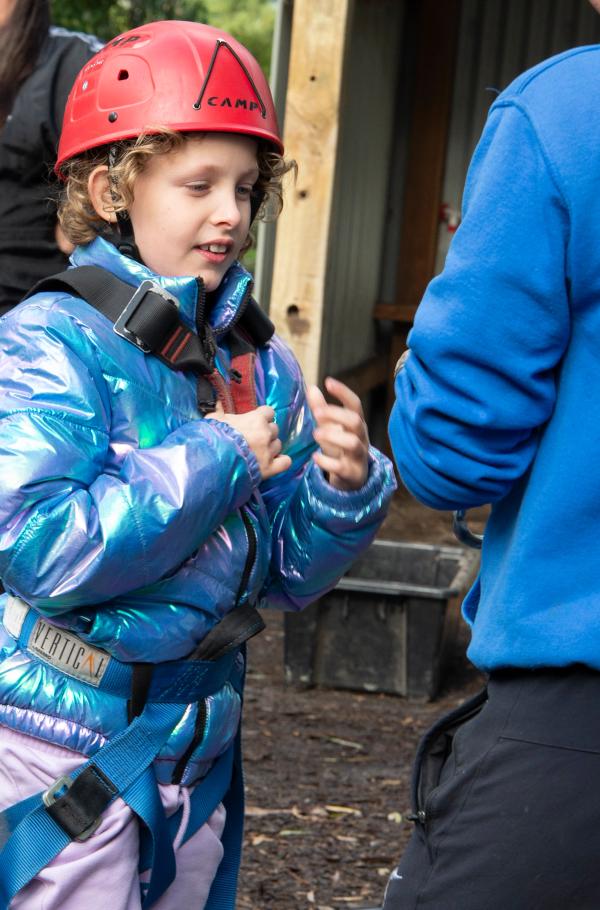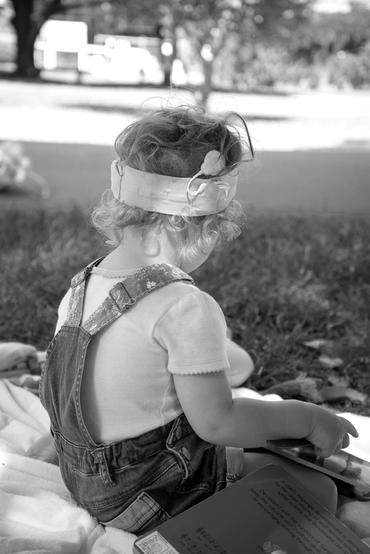Hearing aids - a brief summary
Hearing aids might be recommended to give your child the best chance of hearing what’s going on around them, especially speech.

Hearing aids come in a range of types. Your child might be fitted with two hearing aids (known as a ‘binaural fitting’) or a single hearing aid. Your audiologist will discuss the potential benefits of hearing aids, provide further information, and support you to make an informed decision that’s best for your child.
What do hearing aids do?
Hearing aids make sounds louder and clearer so they’re easier to hear. Modern digital hearing aids can be programmed to suit your child’s hearing needs. The aid will only amplify sounds in the frequencies where there is a loss. This is important, because if all sounds were amplified, loud sounds would become unbearable!
Hearing aids also have technology that helps to separate out speech sounds from background noise, making speech easier to hear.
What types of hearing aids are there?
A few styles of hearing aids are available.
1. Behind-the-ear (BTE) hearing aids
This is the most common type of aid worn by children. BTE aids (also known as post-aural aids) are suitable for young babies upwards. The aid sits behind the ear and is attached to an ear mould. This sits in the ear canal and transmits sound from the hearing aid into the ear.
2. Custom hearing aids
This style of aid includes in-the-ear (ITE), in-the-canal (ITC) or completely-in-the-canal (CIC) aids. In these types of aids, the sound amplifier is built into a custom-made shell that sits inside your child’s ear. These types of aids are only suitable for primary-aged and older children whose growth has slowed and who are not at risk for swallowing the aid.
3. Contralateral Routing of Sound (CROS) hearing aids
These aids may be suited for children with unilateral hearing loss. They look like conventional hearing aids and have two parts. On the deaf side, a microphone in the hearing aid transmits sounds to the aid in the hearing ear. This can help children better hear speech on the deaf side.
4. Bone conduction hearing aid
Some children, such as those with microtia and atresia, may not be able to use a BTE aid. Bone conduction aids bypass the outer and middle ear, transmitting sounds through the head bones directly to the cochlea. Bone conduction isn’t as efficient as air conduction, but may be an option for children who can’t use a traditional hearing aid.

How do hearing aids work?
Hearing aids work by picking up sounds with a microphone and converting them into electrical signals. An amplifier then increases the size of this signal and processes the sound to make it clearer. A receiver then converts this electrical signal back into sound.
Hearing aids amplify some frequencies more than others to adjust for the effects of hearing loss and to make speech easier to understand. Your child’s audiologist will program the hearing aid to ensure sounds never become uncomfortably loud.
How much do they cost?
Many hearing aids are fully government subsidised for children who are deaf or hard of hearing. You may have to contribute to the cost of some aids with extra features or advanced technology. Your audiologist can give you more information about the cost of devices.
Getting used to hearing aids
Hearing aids need to be worn consistently for your child to have the best chance of developing speech and language skills. Some children take to hearing aids quickly, and others, not so much!
To help your child get used to new hearing aids, it’s important the devices are comfortable and don’t create feedback (whistle). It’s a good idea to gradually build up the time your child wears the hearing aid. Have them begin using the aids at a time when they’re relaxed and happy, such as play time, and give them lots of attention and encouragement.
If they remove the aids, stop the activity. Try again once they’re back to being happy. If your child responds well, you can use the aids for 30 to 60 minutes. If not, limit sessions to five minutes or so. You can do this several times per day, then leave them on for increasingly longer periods.
If your child is resistant to using the aids, it can help to involve several family members. Reward your child when the aids are in place.
The goal is for your child to get comfortable with wearing the aids whenever they’re awake. How long this takes will vary significantly. Children are very perceptive and will notice your reaction to hearing aids – whether positive or negative! This can influence how well your child accepts them.
There will always be times when your child takes off the hearing aids, no matter how well things are going. It’s important for you to remain persistent and calm. If you’re feeling stressed, take a break and try again the next day. If you have any concerns or questions, your audiologist can help.
How can I tell whether hearing aids are helping my child?
To see what your child is hearing with their aid, your audiologist will complete various tests. These help to make sure your child's hearing aids are programmed to provide optimal speech intelligibility and comfort.
They will also consider how well the devices are working based on feedback from you, your child (if they’re old enough), and your child’s teachers. Your audiologist will continue to monitor and fine tune the hearing aids to best meet your child’s needs.
It’s important to note that hearing aids don’t restore ‘normal’ hearing. A deaf or hard of hearing child can still find it difficult to hear if the speaker is facing away from them, is too far away, or if there’s a lot of background noise.
Can using hearing aids damage my child’s hearing?
In some circumstances, using hearing aids is associated with worsening of hearing after the ear has been exposed to a loud noise. Hearing aids use technology that helps to provide protection against high level sound inputs. However, a very small number of people may experience temporary worsening of hearing even at typical sound input levels. Regularly using hearing aids at higher than recommended volume settings increases the likelihood of temporary worsening of hearing. This usually resolves overnight and doesn’t cause a permanent change.
Children who frequently use their aids during noisy activities, such as woodwork or metalwork classes, are at increased risk for experiencing a noise-induced hearing change. They should use ear protection during noisy activities.
Your audiologist will be on the alert for any changes. If hearing is worsening, they will test whether the hearing aids are causing it and adjust them appropriately. Your child might also be referred to an ENT specialist to see if a medical condition, which could be treatable, is involved.
Find more handy hints about hearing aids (including how to care for them and tips for using hearing aids with babies) and links to helpful resources - see below.
Research shows children who have hearing loss and consistently use amplification devices (like hearing aids) from an early age have the best spoken language outcomes. For children born with a moderate or higher degree of hearing loss, the best outcomes occur when they start using hearing aids before 6 months of age.
Hearing aids: Handy hints and links to find out more
Hearing aids can make sounds louder and clearer but won’t give your child ‘normal’ hearing. You can help by creating a quiet environment for listening, gaining eye contact, and ensuring you’re facing your child when you speak. Other technologies can also help to make listening easier in environments such as school.
Troubleshooting hearing aids for babies
If your baby is being fitted with hearing aids, two common challenges are keeping them on, and stopping them from whistling.
Whistling happens when ear moulds are loose, which may be often in rapidly growing babies! Ear moulds need to be frequently replaced in the early months and can take a few weeks to make. Moulds come with longer than needed tubing which you’ll need to trim to fit your baby. Ask your audiologist to show you how to do this. Using ear mould lubricant can also create a better seal around the mould and reduce whistling.
Babies also tend to pull hearing aids out and put them in their mouths. Even though battery case doors are tamper-resistant, this can pose a hazard for choking or swallowing a battery or mould.
A popular solution involves using pilot caps over your baby’s ears. Made of soft fabric, these fit snugly over the ears and tie up under the chin, making it more difficult for your baby to pull out the hearing aid. You can buy these from many early intervention services. You can also make a bonnet to help keep hearing aids on your baby. Follow the instructions on this link: Aussie Deaf Kids.
HANDLING YOUR BABY'S HEARING AIDS - A CHECKLIST
Handling your baby’s hearing aids can be tricky in the beginning. You will need to take care of the aids until your child grows and is able to learn more about their hearing aids and using them effectively.
Do you know how to:
- Put your hearing aids and ear moulds on your child?
- Differentiate between right and left hearing aids?
- Differentiate between right and left ear moulds?
- Turn the hearing aids on and off?
- Change the batteries?
- Check the batteries?
- Clean the hearing aids?
- Check and clean the ear moulds?
- Re-attach cleaned ear moulds to the hearing aids?
- Check the tube between the hearing aid and the ear mould?
- Adjust the volume controls (if there are any)?
- Change the switch position for telecoil, and any other special uses (e.g. remote microphone systems device)?
- Do you know how to use the clean and dry kit?
If you can’t answer “Yes” to all the questions or do not feel confident in your ability to handle your baby’s hearing aids, contact your audiologist at Hearing Australia.
The more you know about your child's hearing aids and how to care for them, the more he/she will benefit. Don't be afraid to ask questions. It is the job of the audiologist to give you the information and support you need to manage your baby's hearing aids confidently.
Adapted from Family Notebook – A guide for families with children who use hearing aids. Produced by Oticon.
Handy hints about ear moulds
Caring for ear moulds
Always keep ear moulds as clean and dry as possible. Remove any wax from the canal of the moulds and wipe them with a damp cloth every time you take them out. You can wash ear moulds from behind-the-ear aids with warm soapy water. Dry them thoroughly (an air puffer can help with this) and ensure there’s no moisture in the tubing before reattaching them to the hearing aids.
In-the-ear hearing aids should only be wiped with a damp cloth and any wax removed. Immersing them in water could damage the electronic components inside the mould.
Problems with ear moulds
The ear mould should fit well and comfortably. If feedback (whistling) is a problem, it’s often because the mould is no longer fitting well. The answer is often a new ear mould. You can also try using a lubricant to help it fit better. For ongoing feedback problems, your audiologist can ask the laboratory for specialist help. Some trial and error may be involved, but a solution can almost always be discovered.
Powerful hearing aids require firmly fitting ear moulds, which may lead to discomfort. If an ear mould is hurting, see your child’s audiologist. It may need trimming or modification to create a better fit.
Safety with ear moulds
Ear moulds can pose a choking risk for young children and babies. Always make sure the tubing is pushed tightly onto the ear hook and the material firmly attached to the tubing. Look for safety features like secure battery doors and ear hooks. Your audiologist will give you further safety information. Always keep batteries away from small children.
Handy hints about batteries
Only use the battery size recommended for your child’s hearing aids to prevent damage to the aid. Take notice of the battery size before you throw away the old battery.
A warning tone should let you know when a battery is almost flat. If your child uses two hearing aids, it’s best to change both batteries at the same time. Don’t leave old batteries in for a long period.
Carry spare batteries with you to avoid getting caught out with hearing aids that won’t work.
To increase the life of your batteries:
- avoid opening the tab on the battery packet until you’re ready to use the battery
- ensure you have clean, dry hands before handling batteries
- when the aid isn’t in use, open the battery door to allow moisture to escape
- turn off the aid when it’s not in use
- keep track of how long batteries are lasting – less than five days could indicate your aid needs repair.
Battery safety
Most hearing aids run on button batteries. Keep them in a secure place out of children’s reach. Regularly check the aids to make sure the battery compartment is secured. Have the device checked if it isn’t. Dispose of batteries away from flames and somewhere that can’t be accessed by children. Only recharge batteries that are labelled as rechargeable. Follow all the recommendations for battery safety provided by your audiologist.
If you suspect your child has swallowed or inserted a battery, immediately call the Poisons Information Centre on 13 11 26. You will be directed to the nearest emergency service. Don’t let your child eat or drink until medical professionals have assessed them and do not induce vomiting.



